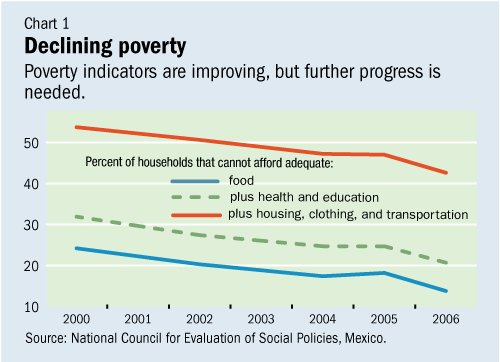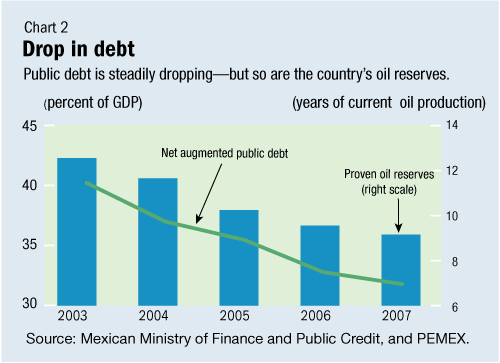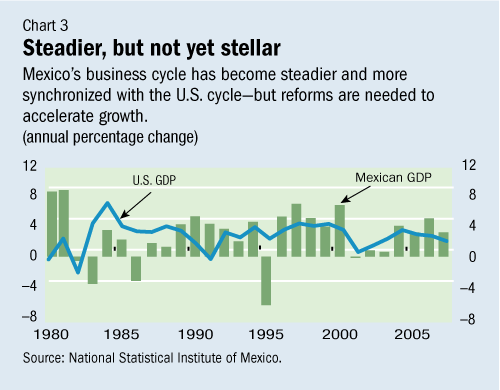IMF COUNTRY ANALYSIS

Typical street scene in Santa Ana, El Salvador. (Photo: iStock)
IMF Survey: Mexico: Building on Reforms to Tap Full Potential
August 22, 2008
- Sound policies have enabled Mexico to withstand recent international turbulence
- Reform agenda aims to boost growth, tackle infrastructure bottlenecks
- Government will have to adapt to a likely fall in oil production
Mexico's economy has achieved broad stability and enhanced resilience in recent years, and the country has enjoyed steady—though not stellar—growth.

Mexico's National Development Plan includes proposals to boost infrastructure, such as this bridge under construction (photo: Notimex/Jorge Arciga).
Strong macroeconomic and financial policies have enabled Mexico to deal well with the recent global financial market turbulence and the economic slowdown in the United States, to which Mexico's economy is closely tied.
But Mexico needs to go further to achieve its economic potential and join the league of fast-growing emerging market countries. Important progress has been made in addressing poverty, but poverty and inequality are still high (see Chart 1). Productivity growth needs to be accelerated substantially. Underlying these challenges are a host of structural problems, including weak infrastructure and education, insufficient competition in key sectors, and inflexible formal labor markets; still-limited financial intermediation; and weaknesses in the rule of law.

The National Development Plan laid out by the new government in 2007 recognizes these challenges, establishing a wide-ranging policy agenda that includes proposals to boost infrastructure spending and press ahead with structural reforms. The plan emphasizes building a more inclusive society that bridges the gap with fast-growing economies while generating more and better jobs.
At the same time, the Mexican government will confront the risk of a sustained drop in oil production, on which the budget now relies for more than a third of its revenue. Proven reserves of oil are less than 10 years' production, and Mexico could cease to be a net exporter of hydrocarbons within about 5 years.
Strengthened policy framework and financial position
Sound policies in recent years have enhanced economic and financial stability in Mexico. The Mexican authorities have met the annual targets for the federal government budget balance, which has produced a gradual decline in the public debt ratio (see Chart 2). The recent Fiscal Responsibility Law seeks to lock in fiscal discipline by holding the budget balance at zero.

Meanwhile, monetary policy has brought annual inflation down to the low single-digit range, in the context of an inflation targeting framework. Even after a barrage of external commodity price shocks, inflation expectations seem anchored, although slightly above the 3 percent inflation target.
Accompanying the inflation targeting regime, Mexico's policy of allowing full flexibility of the exchange rate has been serving the economy well. This transparent policy has facilitated continuous and smooth adjustment to shocks, thereby contributing to internal and domestic stability. The real effective exchange rate seems broadly in line with Mexico's fundamentals.
The country's overall external position has steadily strengthened, and the same is true for its banking system. The external current account deficit—helped by rising oil export prices—has become quite modest and is more than financed by foreign direct investment. External debt ratios have declined to low levels, while foreign exchange reserves have climbed to a comfortable position, primarily reflecting export earnings of the state-owned oil sector. Moreover, the authorities have greatly bolstered financial regulation and supervision over the years. Banks remained well capitalized, profitable, and liquid.
As a result, Mexico has developed greater resilience to external shocks, adjusting smoothly and avoiding disruptive episodes of financial stress and sharp movements in capital flows and the exchange rate. In a "Great Moderation" of the Mexican business cycle, output is much less volatile than in the past, although now more closely linked with the U.S. cycle (see Chart 3).

Deteriorating external environment
Reflecting Mexico's strong fundamentals, the country has weathered well the international financial market turbulence that began in mid-2007. Financial markets functioned normally throughout this period, without need for policy intervention by the authorities. Modest price drops in Mexico's currency, sovereign bond, and stock markets—associated with a global repricing of assets—were smaller than seen in other emerging market countries, and for the most part have been reversed.
Notwithstanding Mexico's many strong links to the United States, its financial institutions were not exposed to problematic U.S. "subprime" assets, and there was no hint of a credit crunch in Mexico. In fact, bank credit growth continued the rapid recovery, albeit from a still-low level, that began several years ago. Amid some deterioration of the consumer loan portfolio, however, banks have increasingly focused on lending more to enterprises.
Mexico's economic expansion continued on a solid footing in 2007, although it was unavoidably dampened by the U.S. economic weakening. With a deceleration of exports—more than 80 percent of which go to the United States—growth for 2007 came out at just over 3 percent, down from an unusually strong performance of almost 5 percent growth in 2006. With some fall in oil output and oil export volume and slower growth of remittances from the United States, the current account deficit widened modestly, to about ¾ percent of GDP in 2007, but was still more than matched by inflows of foreign direct investment.
Confronting challenges ahead
Accelerating growth and reducing poverty will require action on many fronts over the coming years, along with major steps to safeguard the public finances, the National Development Plan acknowledges.
The IMF's latest assessment of Mexico welcomed an impressive start by the new government in addressing these challenges. In 2007, breakthroughs were achieved with several essential, forward-looking reforms, including
• civil service pensions, which put them on a financially sustainable footing, addressing a longer-term fiscal challenge;
• major tax changes gauged to offset the revenue loss from declining oil production in the coming 5 years;
• a package to enhance efficiency and accountability in public spending, including at the subnational government level; and
• further measures to boost competition in the financial sector and expand the private sector's access to finance.
Critical areas
The IMF assessment also noted the importance of building on these recent reforms in several critical areas.
• Using cautiously the upfront revenue gains from recent tax reform, in light of the prospective decline in oil income. The IMF welcomed the government's focus on capital expenditures, while recommending the targeting of existing subsidies to those most in need;
• Following through with plans to strengthen tax administration and expenditure management;
• Moving quickly to reform the declining state-owned oil sector to raise investment as well as efficiency there and potentially reap large gains in the longer term;
• Supplementing the balanced budget requirement with a focus on steadily reducing the government's large non-oil deficit at a time when the future stream of oil revenue is subject to much uncertainty; and
• Enhancing competition, especially in such key network sectors as telecommunications, to generate positive spillovers throughout the economy and promote equity.
Comments on this article should be sent to imfsurvey@imf.org







